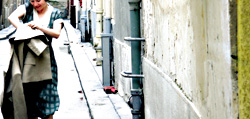Ricki Mason’s work has typically been full of quirky, non-sequitur movement. But with her new solo piece, (i’ve never been good at) ARRANGING FLOWERS, she’s taking a tentative and, at times, confusing step into narrative. “I was somewhat resistant to telling a story before,” says Mason, who has performed with local companies like Lingo dancetheater and BetterBiscuitDance, rising through the usual steps of showcases and shared programs. She says she’s always thought of choreography as akin to “gathering things together that seem related to each other, and then seeing which ones fit into the puzzle. It didn’t make sense to tell a literal story.”
Not that she tells one in ARRANGING FLOWERS, which is split into multiple pieces and spread out across the performance space and even onto her company’s Web site (launchdancetheater.com). It’s set in pre–World War II Paris, where artists hang out in cafes, little jazz groups play long into the night, and a woman in drag is slightly shocking.
Almost everything in the piece is sideways or oblique. The audience sits at the corner of an L-shaped room, so that we have to crane around in our seats to follow Mason as she moves from place to place. One end seems to be a studio apartment, where a more androgynous Mason in T-shirt and jeans bounces and jitters. Here she is a contemporary girl, who’s been smitten by a painting from the 1930s of a young woman in front of a Parisian flower shop. The other end, with a candelabra on the piano and a makeshift bedroom behind a screen in the corner, is the Paris of the painting, where Mason is that lithe young woman in a green dress, describing her romance with the female artist and her fascination with the bohemian life, despite her engagement to a young man.
We get clues to the narrative—text crawling along a television screen in the corner before the show starts, slides flashing on the wall, and chunks of monologue, as well as the suggestive props and evocative music—but as Mason slips in and out of different characters and settings, the truth seems to become more elusive. She is everyone in ARRANGING FLOWERS—the artist, the lover, the subject of the painting, and the seeker after the story—but in the end, the multiple personalities and story lines fade into the suggestion of Paris and the ambiguity of the situation. She’s not always sure who she is, and we’re not either.
Mason has surrounded herself with talented help, including musicians Marchette DuBois and Costi Parvulescu and choreographer KT Niehoff, here performing as a cafe singer in a drop-dead gown. Hallie Kuperman’s photographs of Mason as the young woman in the green dress are particularly evocative, a figure swaying on her high heels, wandering down a Parisian street. There’s champagne for the audience, with the program tied to the stem of the glass; there are snacks and little party favors; there are details galore in this production, but at its heart, as it slips back and forth between Seattle today and Paris back then, the story that Mason is telling turns out to be a mystery.








